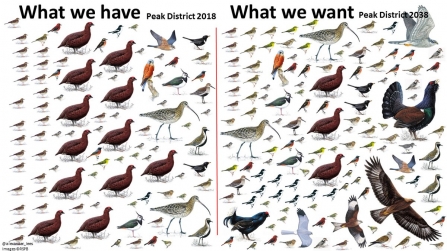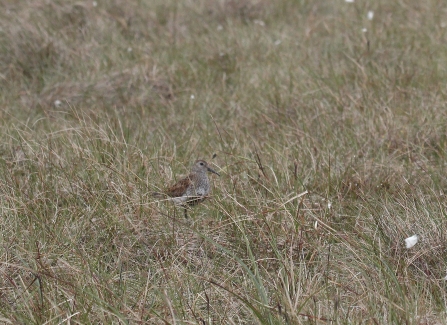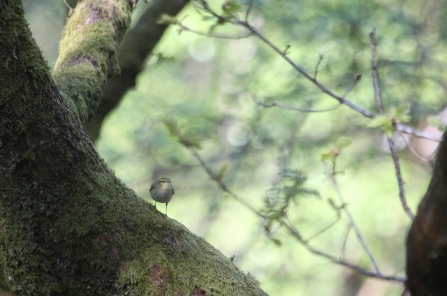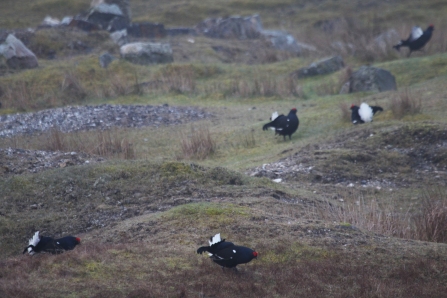Bird communities are never stable. Most people recognise the ebb and flow of migration, the seasonal dynamism that brings joy to many with the first Cuckoo or Swallow. Over longer time scales however, bird populations expand and contract according to local habitat and climatic conditions.
Fifty thousand years ago the Peak District was home to an eclectic avifauna with no contemporary analogues; a Late Pleistocene glacial deposit revealed the bones of species currently absent as breeding birds from the UK like Alpine Swift, Demoiselle Crane and Long-legged Buzzard alongside cold-adapted species like Red grouse and Ptarmigan and temperate zone species like Wood Pigeon and Grey Heron (Stewart & Jacobi 2015).
After the end of the last Ice Age this slow climate-driven reorganisation of flora and fauna was impacted by a greater disruptor – humans arrived on the scene and started to reshape the Peak District with fire and axe. Deforestation lead to the formation of many of the moors and the creation of the first human modified landscapes. Opportunities for some species, but the death knell for others. Species dependent on heavily forested landscapes, perhaps already restricted to climate refuges, like Hazel Grouse disappeared around 5000 years ago with the loss of these forests. Others, like Capercaillie might have persisted for a few thousand more.
As human populations expanded, the Dark Peak came under greater pressure. Space for larger competitors and predators dwindled. Suddenly landscape-level changes that once played out over millennia happened virtually overnight. Our forbears were not keen to share this landscape with top predators and along the with the wolves, bears and lynx, the days of eagles were numbered. A Golden Eagle nest from south of the region at Ossom’s Eyre Cave, Staffordshire and dated at between Romano-British and Stuart times contained the bones of Black Grouse, Red Fox, Badger and the young of Wild Boar and Roe Deer (Bramwell et al. 1987). Evidence for the importance of this top predator in suppressing populations of smaller so-called ‘meso-predators’ as well as ungulates. The last redoubt of the species in the Dark Peak was in the Upper Derwent Valley where a nest was found in 1668 containing a black eaglet “the shape of a Goshawk, and almost the weight of a goose, rough footed, or feathered down to the foot, having a white ring about the tail” (Glover 1831). Persecution rapidly wiped out the species from England. along with other large raptors like Goshawks and Red Kites.
Several centuries later in April 1982 a Golden Eagle, probably one of the offspring of the now extinct Lake District population, briefly penetrated Derbyshire airspace as it overflew Holme Moss (Frost & Shaw 2013). Golden Eagles are not exclusively birds of wild mountains – we have merely driven them there. They breed happily at sea level in places like southern Sweden, all they need to thrive are sufficient prey and to be left in peace. The deep history of this species in the region is reflected in place names across the Peak District (Evans et al. 2012) and we can hope that the species may yet recolonise lost ground if landowners let the species spread south unmolested.
The last two centuries brought unprecedented change, the Dark Peak came to be dominated by three land-uses: extensive sheep walks, grouse moors and conifer plantations. Over time their management has intensified; increasing stocking densities and pasture improvement have resulted in more impoverished plant communities with knock-on effects up the food chain. Native clough woodland was seen as a barrier to progress and productivity, only fragments of this once great temperate rainforest now remain.
Moorland management for Red Grouse required the rigorous suppression of predators, such that most raptors were summarily eliminated by the 19th century. Burning impoverished plant communities, accentuated by drainage and pollution fall out for from the fires of industry of the neighbouring metropolises left huge expanses of bare peat and lunar landscapes. Stands of conifers smothered moorlands once serenaded by Whinchats and Redstarts. Hay fields disappeared, and with them Yellowhammers, Corn Bunting and Twite. Even on the high moors, Wheatears are now notable by their scarcity.




